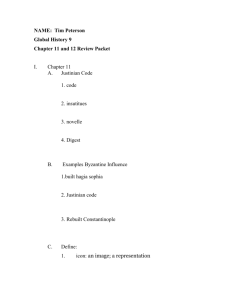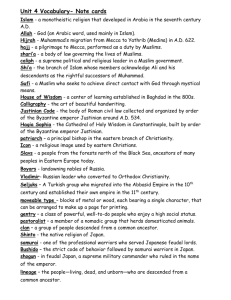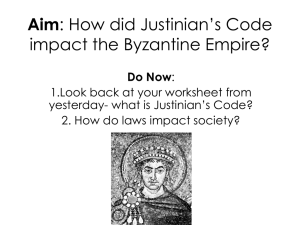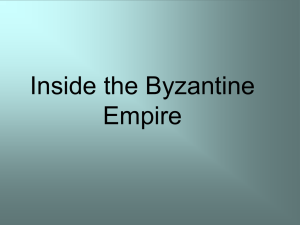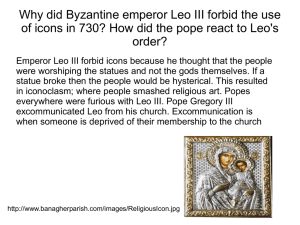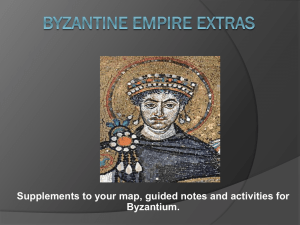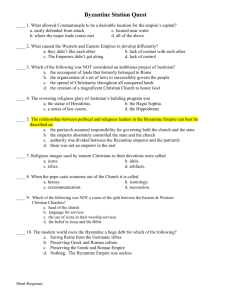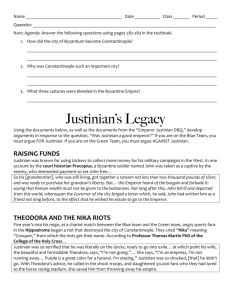Spotlight on Turkey (narrative & outline)
advertisement
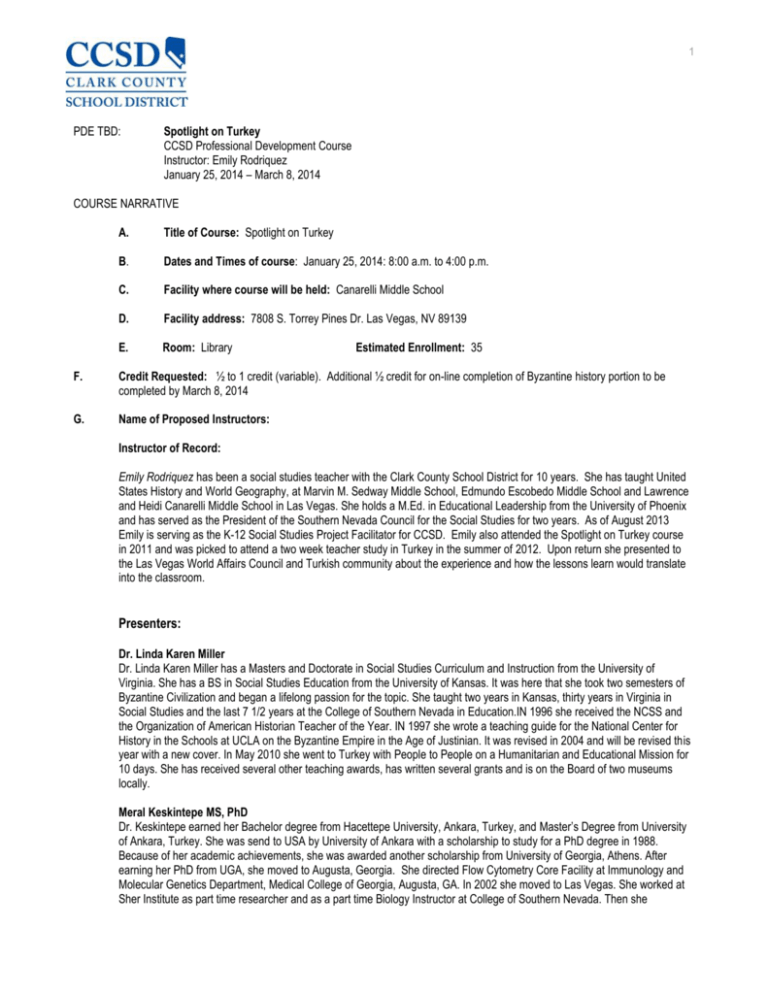
1 PDE TBD: Spotlight on Turkey CCSD Professional Development Course Instructor: Emily Rodriquez January 25, 2014 – March 8, 2014 COURSE NARRATIVE A. Title of Course: Spotlight on Turkey B. Dates and Times of course: January 25, 2014: 8:00 a.m. to 4:00 p.m. C. Facility where course will be held: Canarelli Middle School D. Facility address: 7808 S. Torrey Pines Dr. Las Vegas, NV 89139 E. Room: Library Estimated Enrollment: 35 F. Credit Requested: ½ to 1 credit (variable). Additional ½ credit for on-line completion of Byzantine history portion to be completed by March 8, 2014 G. Name of Proposed Instructors: Instructor of Record: Emily Rodriquez has been a social studies teacher with the Clark County School District for 10 years. She has taught United States History and World Geography, at Marvin M. Sedway Middle School, Edmundo Escobedo Middle School and Lawrence and Heidi Canarelli Middle School in Las Vegas. She holds a M.Ed. in Educational Leadership from the University of Phoenix and has served as the President of the Southern Nevada Council for the Social Studies for two years. As of August 2013 Emily is serving as the K-12 Social Studies Project Facilitator for CCSD. Emily also attended the Spotlight on Turkey course in 2011 and was picked to attend a two week teacher study in Turkey in the summer of 2012. Upon return she presented to the Las Vegas World Affairs Council and Turkish community about the experience and how the lessons learn would translate into the classroom. Presenters: Dr. Linda Karen Miller Dr. Linda Karen Miller has a Masters and Doctorate in Social Studies Curriculum and Instruction from the University of Virginia. She has a BS in Social Studies Education from the University of Kansas. It was here that she took two semesters of Byzantine Civilization and began a lifelong passion for the topic. She taught two years in Kansas, thirty years in Virginia in Social Studies and the last 7 1/2 years at the College of Southern Nevada in Education.IN 1996 she received the NCSS and the Organization of American Historian Teacher of the Year. IN 1997 she wrote a teaching guide for the National Center for History in the Schools at UCLA on the Byzantine Empire in the Age of Justinian. It was revised in 2004 and will be revised this year with a new cover. In May 2010 she went to Turkey with People to People on a Humanitarian and Educational Mission for 10 days. She has received several other teaching awards, has written several grants and is on the Board of two museums locally. Meral Keskintepe MS, PhD Dr. Keskintepe earned her Bachelor degree from Hacettepe University, Ankara, Turkey, and Master’s Degree from University of Ankara, Turkey. She was send to USA by University of Ankara with a scholarship to study for a PhD degree in 1988. Because of her academic achievements, she was awarded another scholarship from University of Georgia, Athens. After earning her PhD from UGA, she moved to Augusta, Georgia. She directed Flow Cytometry Core Facility at Immunology and Molecular Genetics Department, Medical College of Georgia, Augusta, GA. In 2002 she moved to Las Vegas. She worked at Sher Institute as part time researcher and as a part time Biology Instructor at College of Southern Nevada. Then she 2 established a Pre -implantation Genetics Laboratory for Sher Institute for their Fertility Clinics and became full time. Recently she is a Pre-implantation Genetic advisor and collaborating with researchers from Uludag University Medical College, Genetics Department, Bursa-Turkey. Cooking is her passion. She has been working on a Turkish cookbook which has been her dream. William Clayson William Clayson is Professor of history at the College of Southern Nevada. He holds a Ph.D. in history from Texas Tech University and teaches United States History, Western Civilization, Nevada History, and American Military History. His first book, Freedom is Not Enough: The War on Poverty and the Civil Rights Movement in Texas (University of Texas Press, 2010), examines the relationship between Chicano and African American freedom movements in Texas and the Johnson administration’s antipoverty programs in the 1960s and 1970s. Dr. Clayson also holds the rank of Major in the Army Reserve and recently returned from a deployment where he served on the advisory staff of the National Military Academy of Afghanistan. Gunay Ozkan Gunay Ozkan is Professor of Chemistry at the College of Southern Nevada. She holds two master's degrees in chemistry; in Industrial Chemistry from Ege University in Turkey, and in Organic Chemistry from Catholic University in Washington D.C. She taught chemistry at Hasting/Nebraska, Roseburg/Oregon, and she has been teaching all levels of chemistry at College of Southern Nevada since 1999. H. Rationale: Our world has been shaped by its history. We are beginning to realize the relationships and connection we in the US have to the rest of the world. As our world continues to shrink we can benefit from an understanding of world-wide history and culture, especially from a source as rich as the country of Turkey. As part of cultural exchange the local chapter of the World Affairs Council, through the Turkish Cultural Society’s sponsorship, is hosting a one day workshop and (for some of the participants) a trip to Turkey for local teachers to experience first-hand the culture, history, geography and relationship between Turkey and the United States. This information is will enhance the knowledge and cultural understanding of the teacher, who will in turn be able to present what they have learned to their students. The richness of understanding created through this course hopes to have the end result of enhancing the learning of local middle and high school students and helping them move toward global thinking in order afford them greater opportunity in the increasing world market and movement toward world-wide political/social interdependence. I. Nevada K – 12 Social Studies Content Standards This course is designed to help teachers implement the following Nevada Social Studies Standards: i. Standard H1.0: Students understand the development, characteristics, and interaction of people, cultures, societies, religion and ideas. ii. Standard H2.0: Students understand the people, events, ideas, and conflicts that lead to the evolution of nations, empires, distinctive cultures, and political and economic ideas. iii. Standard H3.0 - Social Responsibility & Change - Students understand how social ideas and individual action lead to social, political, economic, and technological change. iv. Standard H4.0 - International Relationships & Power - Students understand the interaction and interdependence of nations around the world. Students understand the impact of economics, politics, religion, and culture on international relationships. v. Standard C16.0: Students explain the different political systems in the world and how those systems relate to the United States and its citizens. J. Course Goal: The goal of this course is for teachers to gain an understanding of the culture, history and geography of Turkey from ancient to modern times that can be incorporated into classroom lesson plans to add an extra level of interest that will enhance student learning. Further, select teachers will be chosen for travel to Turkey as an extension of the workshop and bring their findings back to share with other CCSD teachers, the World Affairs Council of Las Vegas and Las Vegas Turkish community. K. Course Objectives: To provide secondary teachers with the opportunity to examine Turkish culture through workshops that will allow them to experience the cuisine, literature, religion and visual/performing arts. 3 L. To provide secondary teachers with knowledge of the history, geography and economics of Turkey and its influence on modern society in the region and world-wide. To provide secondary teachers with ongoing and sustained professional development in social studies. To provide secondary teachers with guidelines and curriculum to create a relevant lesson plan that can be used in their classroom. To provide secondary teachers with the opportunity to draft a proposal to be chosen to travel to Turkey for participation in a cultural exchange. Learner Outcomes: By the end of this course, participants will be able to: M. Recognize effective instructional strategies for teaching the geography, history and culture of Turkey. Understand the interdependence of Turkey and the United States. Explain the impact Turkey is having worldwide. Course Description: As we enter an era of globalization gaining an understanding of world-wide history and culture, especially from a source as rich as the country of Turkey is extremely beneficial. Learn how to assist your students in moving forward toward global thinking through a day of cultural exchange. The World Affairs Council, together with the Turkish Cultural Foundation, is hosting a oneday workshop for participants to experience first-hand the cuisine, music, culture, history and geography of Turkey. The information provided in this one-day workshop will enhance the knowledge and cultural understanding of participants. These participants will in turn be able to present what they have learned to their students. The hope is to assist our local middle and high school students in moving toward thinking that will afford them greater opportunity in the increasing world market/movement toward world-wide political and social interdependence. In addition a select number of participants will be chosen to complete a continuation of the experience though a two week trip to Turkey where they will gain a deeper appreciation firsthand of all Turkey has to offer. This exchange will be fully-funded (minus registration fees) and will take place early summer 2014. January 25, 2014 - Canarelli Middle School Library 8:00 a.m. – 4:30 p.m. o o o o o o o o o o o o o o 8:00 a.m - 8:30 a.m. 8:30 a.m - 9:00 a.m. 9:00 a.m. - 9:45 a.m. 9:45 a.m. - 10:00 a.m. 10:00 a.m. - 10:30 a.m. 10:30 a.m. - 11:00 a.m. 11:00 a.m. - 12:00 p.m. 12:00 p.m. - 12:30 p.m. 12:30 p.m. - 1:00 p.m. 1:00 p.m. - 2:00 p.m. 2:00 p.m. - 3:15 p.m. 3:15 p.m. - 3:30 p.m. 3:30 p.m.- 4:00 p.m. 4:00 p.m. - 4:30 p.m. 7.5 Hours Registration Opening/Introduction and Welcome by World Affairs Council Las Vegas Lecture on Turkish History - Dr. William Clayson Break Visit Cultural Booths Turkish film Women and Education in Turkey – Ms. Gunay Ozkan Lunch Open Cultural Panel Discussion with Turkish Association representatives Lecture on Current Cultural Climate – Dr. Meral Keskintepe Bringing Turkey to the Classroom - Dr. Linda Miller Break Past participants will briefly share their experiences Proposal Writing and Conclusion Optional Online Course Content 7.5 Hours o The online section of the workshop will be provided to give participants a chance to earn another ½ credit. The course work will come from presenter Dr. Linda Miller’s workbook, The Byzantine Empire in the Age of Justinian A Unit of Study Dr. Linda Karen Miller Published by the National Center for History in the Schools University of California Los Angeles, 1997, revised 2004 o Introduction – 30 minutes Read the Introduction p. 1- 5 to become familiar with the unit of study. 4 Read the Dramatic Moment p. 6. Discussion Questions: o Who were Justinian and Theodora? o Summarize the action. o Describe the role that Theodora played in this incident. o How could you use this in the classroom? Review the Table of Dates p. 7 Discussion Questions: o Identify events that that were contemporary to Constantinople in the Western and Eastern Empire. o How much did you know already about the Constantinople events? How does this compare to your knowledge of the Western and Eastern Empire events? o What conclusions can you draw from that o Lesson One: Geography of the Empire – 1 hour Objectives Analyze how geography influences history. Interpret literary sources about geography of the Byzantine Empire by drawing a map based on verbal descriptions. Lesson Activities Read the material in the Historical Background. Analyze Document A, a map of the Byzantine Empire’s growth during the reign of Justinian. Use the map together with the information from the Historical Background to answer the following question: “How and why did the empire grow during Justinian’s reign?” Read Procopius’ account of the empire (Document B) and compare it with Cassius’ account (Document C) Read various accounts of the geographic position of the Empire (Document D) and draw maps based on the geographic descriptions in the documents. Discuss the importance of the location of Byzantium. Write a journal entry on how geography influenced history in the Empire. o Lesson Two: The Nika Revolt – 1 hour Objectives To evaluate the importance of the Nika Revolt To examine the character of the Emperor in time of crisis Lesson Activities Re-read the “Dramatic Moment.” Read the material in the Historical Background p. 20-22. Using the material from the “Dramatic Moment” and the Historical Background, start a time-line beginning and ending with the life of Justinian. Then add events as you read through the unit. Using Document E, a map of the imperial quarter of Constantinople, locate public buildings on the map and evaluate the position of the Hippodrome in light of the revolt. Refer to the “teacher background” and list differences between the Greens and the Blues. A good reference is A.A. Vasiliev, History of the Byzantine Empire, vol 1. Read Document F about the Nika Revolt. Pretend you are an adviser to Justinian or a Blue or a Green. Write a paragraph presenting your concern to the Emperor. Answer the following questions: o What were the causes of the revolt? o What could Justinian have done differently? o What role did Theodora play? o What does this incident reveal about the character of the emperor? o What were the effects of the revolt? o Lesson Three: The Vandal War in Africa – 1 hour Objectives 5 To examine the significance of the Vandal War in Africa. To compare two different viewpoints on the war. Lesson Activities Read the material in the Historical Background. Locate the expansion of the Byzantine Empire into Africa during Justinian’s reign (Document G). Read the historian Procopius’ account of the Vandal Wars (Document H) and answer the following questions: o Why was it important to restore Africa to the empire? o What are some of the problems that the conquest caused the Byzantines? The Vandals? The native North Africans? Read Document 1, the speeches of the Roman Belisarius and the Vandal Gelimer. Write a paragraph comparing the two speeches. What techniques did they use to inspire their men? Summarize the main elements of each viewpoint. o Lesson Four: Justinian as a Law Reformer – 1 hour Objectives To analyze the importance of having a written legal code. To draw conclusions from primary source materials. Lesson Activities In a discussion post address the following questions: o Why is it important to have laws? o What are the benefits of having written laws? o What are the disadvantages of having written laws? Read over the material in Historical Background. Question: What class difficulties existed before Justinian codified the laws? Compare this to modern countries in conflict. Read excerpts from Justinian’s Code, “The Institutes” (Document J) and “Digest of Roman Law”, (Document K). Answer the following questions in your journal: o Explain the difference between manifest and non-manifest. o Define “injury” as used in the code. o What can one tell about the values of a society from reading their laws? What conclusions can you draw about the Byzantine society? o What influence did Theodora have on Justinian? Write a law that could have been written during the time of Justinian or Write an account of a “manifest” crime that might have taken place during the time of Justinian. o Lesson Five Byzantine Architecture – 1 hour Objectives To appreciate the innovative contributions of the Byzantines in architecture. To realize the lasting influence of the dome on construction of great religious buildings. To analyze religious influence on architecture. Lesson Activities Read the material in the Historical Background. Read the selection from Buildings by Procopius (Document I) and answer the following questions in your journal: o Why was the Hagia Sophia rebuilt? o What was the importance of this building? o How did the builders solve architectural problems? o How did the people react to the church? o What purpose has the building served since the mid-15th century? o Why do you think Justinian gave Anthemius the commission to build the Hagia Sophia? o How is Hagia Sophia constructed differently from earlier churches? o How does Procopius describe the physical appearance of the church? Analyze the plan of the cathedral, Hagia Sophia (Document M). Look at the diagram of a Byzantine dome (Document N) and compare it with the dome on Brunelleschi’s Cathedral of Florence. 6 Using the sketch of Hagia Sophia (Document 0) describe what you see in your on-line journal. o After looking at these create discussion post that addresses What is your opinion on this architecture? What might be the engineering problems of dome architecture How did the dome influence the style of the rest of a structure? o Lesson Six: Justinian and Theodora – 1 hour Objectives To understand that primary source material can be biased. To speculate on why Procopius wrote such an unfavorable account of Justinian. To draw comparisons to modern day reporting about leaders. To evaluate the accomplishments and failures of Justinian’s rule and consider his legacy. Lesson Activities Read the material in the Historical Background. Read the excerpts from Procopius’ Secret History (Document P) along with the secondary sources in “Justinian and Theodora” (Document Q). The Historical Background essay makes clear the strong bias against Justinian and Theodora that Procopius expresses in his Secret History. Write down specific passages that indicate bias. If this account has a negative view of the emperor and empress. Can you find any bias in the five secondary source accounts in Document Q? Discussion Post: How are present day leaders presented to the public in the press or other public forums? Think of examples of leaders who have been ”slammed” in the way that Procopius spoke ill of Justinian and Theodora. Examine the mosaics of Justinian and Theodora (Document R) from Ravenna Italy in the Church of San Vitale. Answer the following questions in your journal: o How are mosaics made? o What is Justinian holding? o What is Theodora holding? What does that symbolize? o How are they (Justinian/Theodora) placed in the composition? What does their placement tell you about their position in society? o What conclusions might you draw about their personalities from the mosaics? o Would Procopius agree with the portrayal of the emperor and the empress in the mosaics? Explain. o Unit Evaluation Activities – 1 hour Write a newspaper about events during the time of Justinian. The stories should include the Nika Revolt, the Vandal Wars, and the building of the Hagia Sophia. The paper should include news accounts, editorials, political cartoons and travel sections. Using the sources from the unit, evaluate Justinian’s rule. Make a list of Justinian’s accomplishments and failures. Read “Justinian’s Legacy” Document S. Should Justinian be inducted into the hall of fame or hall of infamy? Total Hours: 7.5 or 15.0 M. Methods of Instruction: Face to face instruction, workshops style presentations, demonstrations and lecture from experts, discussion, and modeled instruction with guided practice. N. Students: This course is open to all 6-12 teachers. O. Method of Grading: This course is pass/fail. Participants who attend all sessions and actively participate will earn PDE credit.
